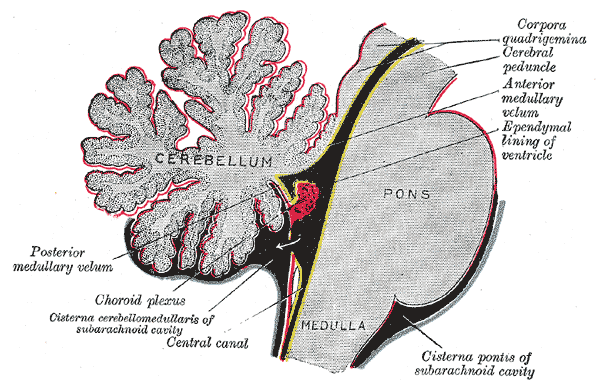 |
This is a file from the Wikimedia Commons. Information from its description page there is shown below.
Commons is a freely licensed media file repository. You can help.
|
| Description |
Gray708.svgvectorisation of see other version section
- : posterior medullary velum
- : Choroid plexus
- : Cisterna cerebellomedullaris of subarachnoid cavity
- : Central canal
- : Corpora quadrigemina
- : Cerebral peduncle
- : Anterior medullary velum
- : Ependymal lining of ventricle
- : Cisterna pontis of subarachnoid cavity
Arrow = Flow of cerebrospinal fluid (CSF) through foramen of Magendie |
| Date |
25 November 2006 |
| Source |
 |
| Author |
lyhana8 |
Permission
( Reusing this file) |
PD
|
This image was improved or created by the Wikigraphists of the Graphic Lab (fr). You can propose images to clean up, improve, create or translate as well.
বাংলা | català | česky | Deutsch | Deutsch (Sie-Form) | Ελληνικά | English | Esperanto | español | suomi | français | עברית | magyar | Հայերեն | italiano | 한국어 | македонски | Bahasa Melayu | Plattdüütsch | Nederlands | occitan | polski | português | română | русский | slovenščina | svenska | татарча/tatarça | Türkçe | українська | 中文 | 中文(简体) | 中文(繁體) | Zazaki | +/−
| Public domainPublic domainfalsefalse |
|
|
This media file is in the public domain in the United States. This applies to U.S. works where the copyright has expired, often because its first publication occurred prior to January 1, 1923. See this page for further explanation.
|
|
|
|
This image might not be in the public domain outside of the United States; this especially applies in the countries and areas that do not apply the rule of the shorter term for US works, such as Canada, Mainland China (not Hong Kong or Macao), Germany, Mexico, and Switzerland. The creator and year of publication are essential information and must be provided. See Wikipedia:Public domain and Wikipedia:Copyrights for more details. |
|
File usage
The following pages on Schools Wikipedia link to this image (list may be incomplete):
This file contains additional information, probably added from the digital camera or scanner used to create or digitize it. If the file has been modified from its original state, some details may not fully reflect the modified file.
All five editions of Schools Wikipedia were compiled by SOS Childrens Villages. SOS Childrens Villages helps more than 2 million people across 133 countries around the world. Try to find out how you can help children in other countries on our web site.




